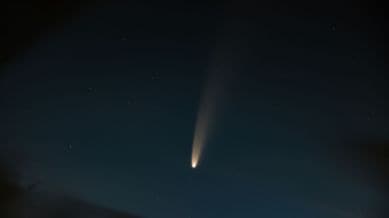Unprecedented brightening of interstellar Comet 3I/ATLAS reported in new research
The finding is significant because the internal composition of 3I/ATLAS could suggest that the planetary system from which it originates has a unique chemical makeup.

Scientists are intrigued by the mysterious behaviour of Comet 3I/ATLAS, which recently exhibited an unprecedented and rapid increase in brightness as it approached the Sun — a phenomenon that remains unexplained.
This comet is only the third known interstellar object to enter our solar system, following the elongated asteroid ‘Oumuamua (discovered in October 2017) and 2I/Borisov, the first interstellar comet, observed in August 2019. Such visitors from beyond our solar system offer rare insights into the chemical composition and evolution of distant planetary systems.
monthly limit of free stories.
with an Express account.
As 3I/ATLAS neared perihelion — its closest point to the Sun — on October 29, 2025, researchers expected a gradual brightening, similar to comets originating from the Oort Cloud, a distant reservoir of icy bodies at the solar system’s edge. Typically, comets brighten due to sublimation — the direct transformation of ice into gas under solar radiation. This process releases dust and gas that form a luminous halo, or coma, and the distinctive cometary tail. The reflected light from the expanding dust usually accounts for the observed increase in brightness.
However, in the case of 3I/ATLAS, the brightening occurred far more rapidly than expected.
In a new paper published on the research repository arXiv, Karl Battams of the Naval Research Laboratory, Washington DC, and Qicheng Zhang of the Lowell Observatory, Flagstaff, Arizona, reported that “the reason for 3I’s rapid brightening, which far exceeds the brightening rate of most Oort Cloud comets at similar radial distances, remains unclear.”
The unusual event was detected by several space-based observatories, including the Solar and Heliospheric Observatory (SOHO), the GOES-19 meteorological satellite, and NASA’s twin spacecraft, STEREO-A and STEREO-B (Solar Terrestrial Relations Observatory). Because the comet is currently lost in the Sun’s glare, ground-based telescopes will not be able to observe it again until mid- to late-November 2025, when it enters its post-perihelion phase.
The researchers have proposed multiple hypotheses to explain the anomaly. The brightening could be linked to 3I/ATLAS’s high velocity as it approaches the Sun, or it could reveal intrinsic differences in the comet’s composition or structure compared to typical Oort Cloud comets.
“The finding is interesting because if the internal composition of 3I/ATLAS is different from that of the nuclei of Oort Cloud comets, it could suggest that the planetary system from which it originates has a unique chemical makeup,” the authors note.
They add, “Oddities in nucleus properties like composition, shape, or structure — which might have been acquired from its host system or over its long interstellar journey — may likewise contribute to the rapid brightening. Without an established physical explanation, the outlook for 3I’s post-perihelion behaviour remains uncertain. A plateau in brightness, a brief continuation of its pre-perihelion brightening, or even a rapid fade all appear equally plausible.”
Interestingly, the team also observed that carbon dioxide sublimation seemed to dominate the comet’s activity even when it was just three times farther from the Sun than Earth, suggesting that cooling effects might have delayed water-ice sublimation, altering the expected thermal response.
The findings highlight how little is yet understood about interstellar comets — and how each new arrival offers a fresh glimpse into the dynamic chemistry of distant solar systems.